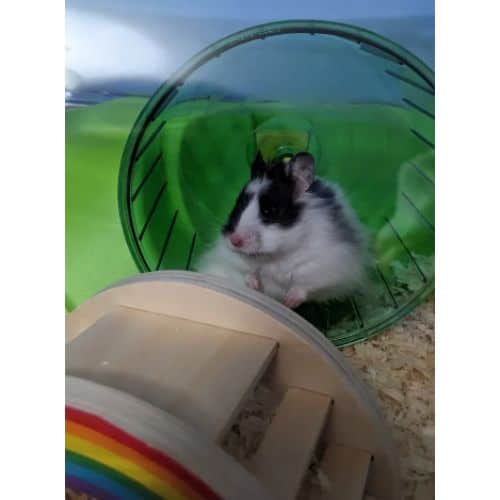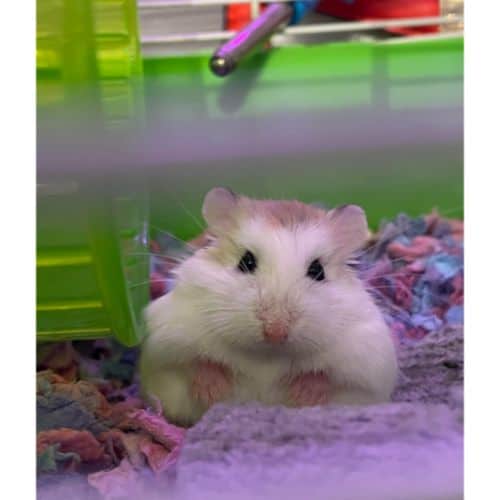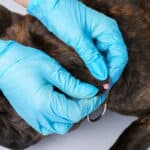Cancer as a disease is a common denominator amongst most animals.
While some may have lesser chances of getting it, most animals tend to suffer from cancer in one form or another.
This begs the question, can hamsters have testicular cancer?
Yes, hamsters can have testicular cancer, just like humans and other animals. Due to their relatively short lifespan, early diagnosis is critical to ensuring they get adequate treatment.
In this article, we’re going to go over how you can diagnose, treat, and take good care of your hamster if they have testicular cancer. So, keep reading!
Before you scroll further down this guide, check out these other hamster-related articles: Best Hamster Breeders in The UK and Dogs and Hamsters: What To Expect & How To Make It Work.
Table of Contents
Is Testicular Cancer Common in Hamsters?

Yes, testicular cancer does occur in hamsters, but it is not as common.
This is primarily because hamsters have a short lifespan, usually around 2-3 years. This minimizes their exposure to factors that can lead to cancer.
Secondly, since they have a quicker metabolism, it is mistaken as resilience for diseases like cancer.
But, just like all other mammals, hamsters are susceptible to various forms of cancer, including cancer.
Older hamsters and those with genetic predispositions have a higher chance of getting testicular cancer.
How Do Hamsters Get Testicular Cancer?

Just like other mammals, testicular cancer in humans starts as a tumor or abnormal growth in the testes.
Over time, these growths can become cancerous. It may spread to other parts of the body if not detected and treated promptly.
Let’s explore the factors that contribute to this form of cancer in hamsters.
Cause of Testicular Cancer in Hamsters
The factors leading to testicular cancer in hamsters are not yet fully understood but may include:
Genetic Factors

Hamsters may have a predisposition to testicular cancer. Inbreeding can exacerbate the risk, as limited gene pools may include cancer-susceptible genes.
Hormonal Imbalance
An imbalance in sex hormones, particularly testosterone, can potentially influence the development of testicular cancer in hamsters.
These play a pivotal role in cell growth and division. So, an imbalance in hormones can cause cells to grow uncontrollably, leading to tumors.
Environmental Triggers

Elements in the hamster’s environment could lead to cancer development. Exposure to substances like these, like pesticides and plastics, are considered risk factors.
But this is only speculative, as pesticides and plastics are known to increase the risk of cancer in humans.
However, there has been no empirical study conducted for hamsters.
Considering the fact that both species can suffer from testicular cancer of relatively the same type, inferring that hamsters may also share the same risk factors makes sense.
Diet and Nutrition
While not commonly considered, a poor diet that lacks essential nutrients can contribute to various health issues, including cancer.
A poor diet leads to a weakened immune system, leading to a hamster being more susceptible to disease, which includes testicular cancer in hamsters.
Stress and Well-Being

Stress does not directly contribute to testicular cancer in hamsters. However, it does weaken their immune system by a significant margin.
As we’ve mentioned prior, a weakened immune system increases the risk of cancer.
Can I Stop My Hamster from Getting Cancer?

No, you cannot stop your hamster from getting cancer, as there are multiple factors at play that can cause it in the first place.
Of course, if you take great care of your hamster, give it proper food, shelter, and care, and have regular veterinary check-ups, it significantly reduces the chances of it getting cancer.
Plus, early detection by virtue of the hamster being taken often to the vet goes a long way in effective treatment due to the inherent short lifespan of hamsters.
Here are a few steps you can take to help reduce the chances of cancer for your hamsters:
- Consult Your Veterinary Doctor Regularly: A proactive approach involves regular vet visits for professional evaluations. These can aid in early detection and intervention, helping control the progression of the disease.
- Stress Management: Reducing stress through a comfortable environment alongside adequate mental stimulation aids in overall well-being, indirectly helping in cancer prevention.
How to Find Out If My Hamster Has Cancer?

Detecting cancer in a hamster requires a multifaceted approach, encompassing keen observation, advanced diagnostics, and professional advice.
Let’s break it down, step-by-step, as to how you can figure out if your hamster has cancer:
Physical and Behavioral Anomalies: The Early Signs
Before you even consider advanced diagnostics, your first line of defense lies in daily observation. Here’s how to do it in the most effective manner:
- Lumps or Swellings: These may appear anywhere on the body and could vary in size and texture. A rapid increase in size is particularly concerning.
- Unexplained Weight Loss: Weight loss that occurs over a short period or seems disproportionate to diet and activity level should warrant attention.
- Loss of Appetite: This is more than just your hamster not eating a meal or two; it’s a consistent, ongoing lack of interest in food.
- Behavioral Changes: Keep an eye out for mood swings, lethargy, or unusual aggression. While not specific to cancer, these are indicative of systemic issues like malignancies.
- Difficulty Breathing: Respiratory issues can sometimes point to lung cancer or metastases.
In-Depth Home Examinations

For those who want to go the extra mile in monitoring their pet’s health, periodic in-depth home examinations can be valuable:
Skin and Fur Check
This goes beyond a mere glance. You’ll be checking for asymmetries, discoloration, sores, or flaky skin.
Use both visual inspection and tactile palpation methods for thoroughness.
Use a soft brush to gently pat the fur for a more unobstructed view. Look for areas that appear darker, reddish or unusually pale.
Tactile Palpation
Now, transition to the tactile inspection. Gently run your fingers over your hamster’s body, feeling for lumps, growths, or inconsistencies.
The idea here is to be gentle yet thorough. Your aim is to map any variation in texture or density that might indicate a deeper problem.
Instruments

If you are very concerned, utilize a magnifying class, as it can help with visual inspections.
Also, consider using imaging tools such as dermatoscopes designed for pets, elevating your inspection to near clinical standards.
Advanced Diagnostics: The Final Step That Leads to Confirmation
If the above examinations reveal worrying signs, escalate the issue to professional diagnostic evaluations.
- Blood Tests: Comprehensive panels can provide insights into organ functions and other systemic issues.
- Imaging: Ultrasound and X-rays provide a look into the internal organs of a hamster that may have testicular cancer. This helps in locating tumors that are not evident through a physical examination.
- Biopsy: If a lump or mass is detected, a biopsy provides cellular-level analysis to confirm or rule out malignancy. This can be critical for deciding what to do next.
Of course, if you’ve reached this point, there’s absolutely reason for you not to consult a professional.
So, even if you have the slightest doubt that your hamster may have testicular cancer, immediately consult a professional and get an expert diagnosis on the matter.
The quicker you get testicular cancer diagnosed on a hamster, the higher their chances of survival and the easier their treatment plan.
Beyond a certain stage, cancer proves to be fatal, with modern-day medicine not being able to do much against the deadly disease.
What to Do If My Hamster Has Cancer?

Before you embark on treating your hamster’s cancer, consult a veterinary oncologist for a specialized and accurate diagnosis.
These professionals have extensive experience and will guide you through all treatment options available.
After the exact type and stage of cancer is recognized, your hamster will undergo a number of diagnostic tests.
These are usually blood tests, X-rays, ultrasounds, and biopsies. These not only confirm the diagnosis but also help tailor the treatment plan.
After the cancer has been diagnosed, here are a few treatment options that your vet may recommend:
Surgical Removal of the Tumor
If the cancer happens to be localized, surgical removal of the tumor can be curative.
It is one of the most direct and effective way to eradicate cancerous cells, especially when the tumor is accessible.
Chemotherapy

For metastasized, advanced, aggressive cancers, chemotherapy is the go-to treatment.
While effective, it is vital to discuss the risks and side effects of it, like nausea and fatigue, with your veterinarian.
Immunotherapy
A new entrant in veterinary oncology, immunotherapy helps boost the hamster’s own immune system to combat cancer.
This could be groundbreaking for resistant cases. However, it hasn’t been used much at its current stages.
What If My Hamster Cannot Be Treated?

Cancer is a vicious disease, and there’s a chance that regardless of the advances made in the world of medical care, your hamster may not be able to survive the disease.
If that’s the case, here are some steps you need to look into if your hamster is undergoing treatment or can’t be treated:
- Prioritize a Healthy Diet: If diet was the reason your hamster has cancer, diet could be the way it gets out of it. A balanced, nutrient rich diet can play a major role in your hamster’s cancer treatment. Consult your vet for customized nutritional advice to meet your hamster’s unique needs.
- Pain Management: Effective pain management strategies, which include analgesics and other medications, are essential for ensuring your hamster’s comfort during this challenging time.
- Environmental Comfort: Soft bedding, warmth, and quietness also play roles in minimizing stress and discomfort for your hamster.
What Else Can I Do For My Hamster?
Your hamster will require emotional support from you during this difficult period. You can help by:
- Providing a Stimulating Environment: This could include toys, or new layouts in their enclosure to explore.
- Physical Comfort: Gentle stroking and comfortable bedding can provide a sense of well-being to your hamster.
- Companion Animal: Some hamsters respond positively to companion animals. Since the disease is not contagious, it can help them interact and socialize. However, consult your vet to ensure it is the right choice.
Hospice: The Last Resort

In some cases where treatment is not viable, the focus may shift to palliation. Here, you may consider setting up a home hospice care.
The primary aim of hospice is to provide a dignified setting for your hamster to live out its remaining days.
This includes pain management, proper feeding, and cleanliness. Consult your vet on how to set up a hospice environment at home.
What To Do If My Hamster Passes Away From Cancer?

Losing a pet is never easy, but knowing what steps to take can offer some comfort and closure:
- Consult the Vet: Discuss with your vet about how you can handle the body best. Some may offer cremation services or guide you on home burial.
- Memorialize: Create a small memorial or a keepsake to remember your pet. This could be a scrapbook of photos or a small service.
Conclusion For “Testicular Cancer In Hamsters”

Testicular cancer in hamsters, while not common due tot heir short lifespan, can indeed occur.
Early diagnosis and treatment are key to managing this condition effectively.
From preventative steps to detection and treatment plans, there are multiple strategies to manage your hamster’s health effectively.
If you find this guide, “Testicular Cancer In Hamsters” informative and helpful, you can check out these other animal-related articles from our team:
You can learn more about hamsters by watching “23 Hamster Behaviours 🐹” down below:




